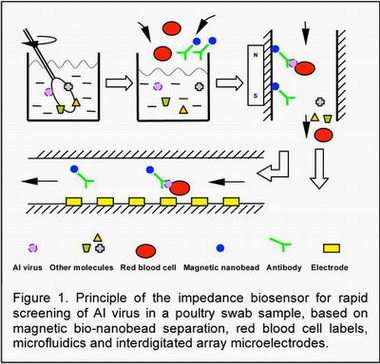Rapid Response to Avian Flu Threat

An interdisciplinary team of researchers led by Yanbin Li, professor of biological engineering in the University of Arkansas Division of Agriculture, has developed a portable biosensor for in-field, rapid screening of avian influenza virus.
The inexpensive device specifically and sensitively detects the avian influenza strain H5N1 from poultry cloacal or tracheal swab samples in less than 30 minutes and could help health officials coordinate a rapid response for the eradication, quarantine and vaccination of animals.
"Rapid detection is the key to controlling the spread of avian influenza," Li said. "Techniques currently used to detect the disease are either time consuming, too expensive or not specific to subtypes of avian influenza viruses. Our device provides robust and reliable results and introduces the concept of real-time detection to facilitate a coordinated and rapid response."
The research team, composed of Li; Billy Hargis, professor of poultry science; Steve Tung, associate professor of mechanical engineering; and Luc Berghman, associate professor of immunology at Texas A&M University, combined their expertise in biosensors, virology, immunology, microfluidics, poultry diseases and micro-electromechanical systems to design, build and evaluate a prototype device that is portable and simple and provides rapid, specific and sensitive detection of avian influenza virus.
The biosensor is a portable instrument designed for field use. It can be operated as a stand-alone instrument or connected to a laptop computer for data acquisition, analysis and control. The researchers are currently pursuing funding for further testing and evaluation. Li said he expects the device to be ready for commercial production in one year. As a commercial product, the biosensor would cost less than $8,000, Li predicted, and testing fees would be less than $10 per sample.
Based on Li's previous research on impedance biosensors to detect Salmonella and E. coli, the new system uses magnetic bio-nanobeads, a specially designed microfluidic biochip and red blood cell complexes to detect the virus. Detection follows a step-by-step process. First, researchers coat the magnetic nanobeads with specific antibodies to separate and concentrate the target virus within a poultry swab sample. Acting as bio-labels, red blood cells are then mixed with the captured virus to form a complex, which is filtered by a specially designed, micro-fluidic biochip. The biochip then delivers the complex to a microelectrode array for measurement. Researchers detect the specific virus by correlating the change in impedance of the complex under high-frequency and alternating currents to the concentration of avian influenza virus in an original sample.
To optimize the research prototype, the research team is currently developing specific monoclonal antibodies to different subtypes of avian influenza viruses. Another UA researcher, Ryan Tian, assistant professor of chemistry, is developing a titanium dioxide nanofiber to modify the microelectrode for a more sensitive impedance signal from the target virus. When Tian's work is completed, the research team will be ready to conduct field tests for the final evaluation of the technology. Working with specific monoclonal antibodies, Li is also collaborating with researchers at China Agricultural University to develop wireless communication, global positioning systems and imaging for the biosensor's application to a rapid response to animal disease networks in China.
Avian influenza virus H5N1 was discovered in the late 1990s. Animal cases have been reported in more than 46 countries, and 10 countries have reported human infection. As of Jan. 22, according to the World Health Organization, 269 people have been infected, and 163 have died since 2003 due to avian influenza. Recently, a draft report of the U.S. government's emergency plan predicts that as many as 200 million Americans could be infected and 200,000 could die within a few months if an avian flu pandemic were to reach the United States.
In the United States, a 2001 and 2002 outbreak of low pathogenic avian influenza, which poses no threat to humans, resulted in the loss of more than 4.5 million chickens and turkeys and is estimated to have cost the poultry industry approximately $125 million. According to a World Bank report, by mid-2005 more than 140 million birds had died or been destroyed worldwide, and losses to the poultry industry are estimated to be more than $10 billion.
Source: University of Arkansas


















